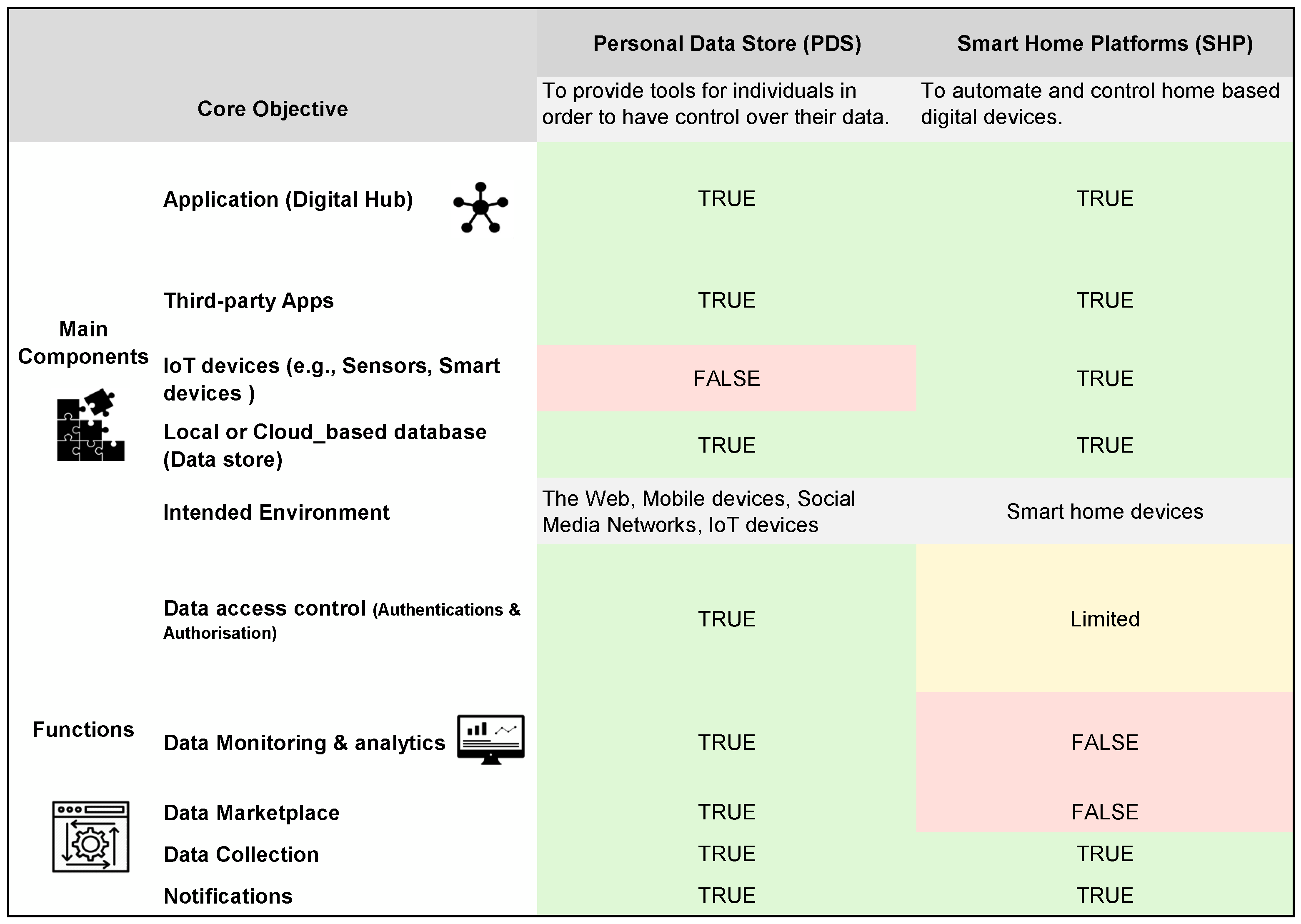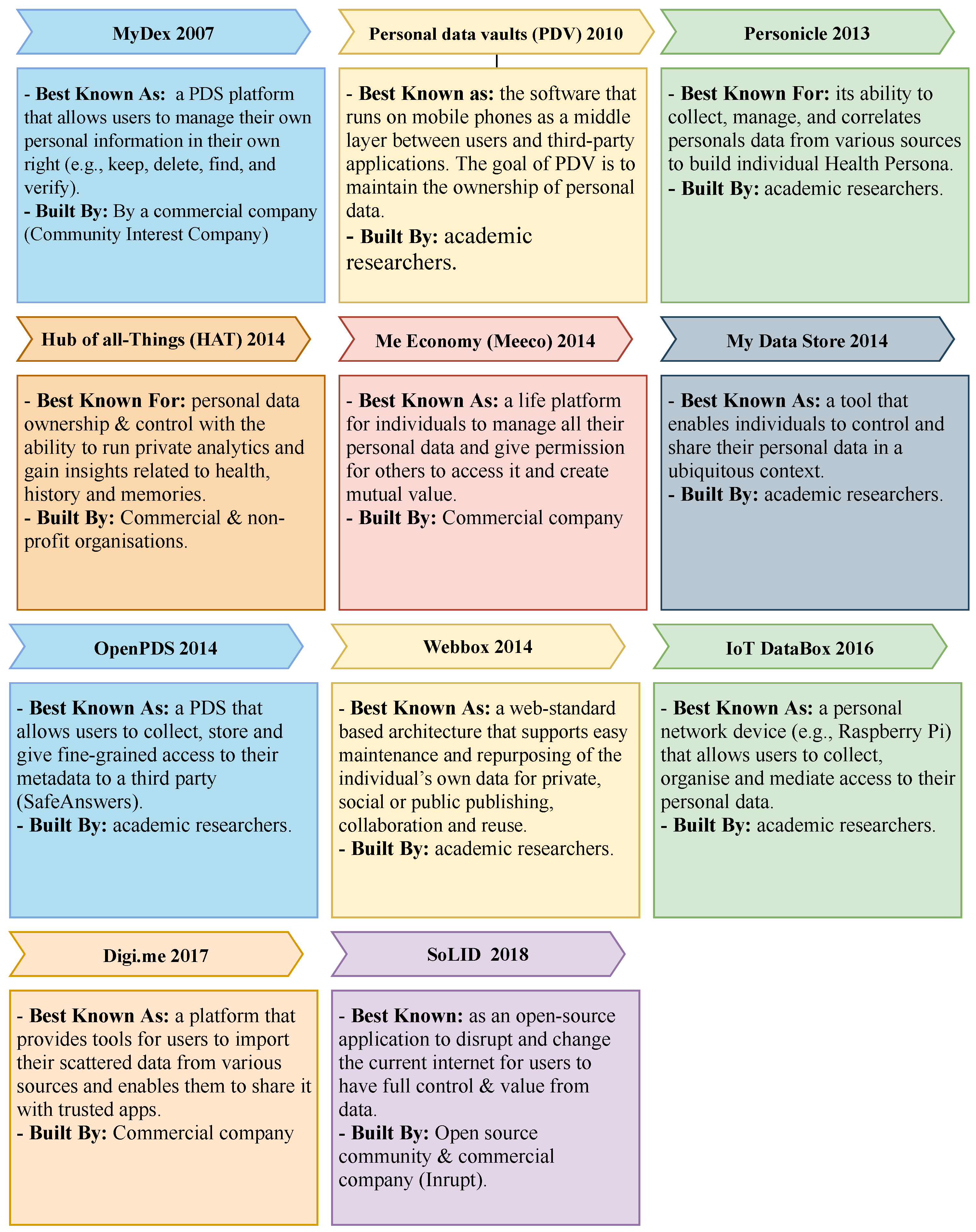The idea of the personal data store goes back to the early 2000s. The initial idea of this concept was to store and capture digital materials (e.g., books, photos, and other digital documents). This idea was developed for MyLifeBits as a platform to store scanned paper files and record, store, and access a personal lifetime archive. Personal web observatories are another concept based on the idea of PDS. A personal web observatory is a technical platform that, first and foremost, enables individuals to consolidate and archive their data that is dispersed among multiple sources. Later, the concept of Personal Information Management (PIM) and Personal dataspace management was introduced to specifically focus on the process of managing personal digital information such as emails, images, HTML, XML, audio, video, and so on.
- internet of things
- personal data store
- data vaults
1. Privacy as a Driver for Personal Data Stores (PDS) to Flourish
2. Data Sovereignty as a Legal Requirement
3. The Anticipated Advantages of PDS Model
4. The Disadvantages of the PDS Model
5. Smart Home Platforms as a PDS

6. Using PDS Platforms for Enabling Personal Data Marketplace
7. Key Enabling Technologies for PDS Platforms
8. Existing PDS Platforms

This entry is adapted from the peer-reviewed paper 10.3390/s23031477
References
- Brochot, G.; Brunini, J.; Eisma, F.; Larsen, R.; Lewis, D. Study on Personal Data Stores Conducted; The Cambridge University Judge Business School: Cambridge, UK, 2015; pp. 458–459.
- Van Kleek, M.; Smith, D.A.; Murray-Rust, D.; Guy, A.; O’Hara, K.; Dragan, L.; Shadbolt, N.R. Social personal data stores: The nuclei of decentralised social machines. In Proceedings of the 24th International Conference on World Wide Web, Florence, Italy, 18–22 May 2015; pp. 1155–1160.
- Perentis, C.; Vescovi, M.; Leonardi, C.; Moiso, C.; Musolesi, M.; Pianesi, F.; Lepri, B. Anonymous or not? Understanding the factors affecting personal mobile data disclosure. ACM Trans. Internet Technol. 2017, 17, 1–19.
- Duisberg, A. Legal Aspects of IDS: Data Sovereignty—What Does It Imply? In Designing Data Spaces; Springer Nature Switzerland AG: Cham, Switzerland, 2022; pp. 61–90.
- Hummel, P.; Braun, M.; Augsberg, S.; Dabrock, P. Sovereignty and data sharing. ITU J. ICT Discov. Spec. Issue 2018, 25, 1–10.
- Scerri, S.; Augustin, S. Industrial Data Space—Digital Sovereignty over Data. In Proceedings of the Digitising European Industry WG2 Meeting, Brussels, Belgium, 8 December 2016.
- Chaudhry, A.; Crowcroft, J.; Howard, H.; Madhavapeddy, A.; Mortier, R.; Haddadi, H.; McAuley, D. Personal Data: Thinking Inside the Box. Aarhus Ser. Hum. Centered Comput. 2015, 1, 4.
- Janssen, H.; Cobbe, J.; Norval, C.; Singh, J. Decentralised Data Processing: Personal Data Stores and the GDPR. SSRN Electron. J. 2020, 10, 356–384.
- Ctrl SHIFT. The New Personal Data Landscape; Technical Report. 2011. Available online: https://www.ctrl-shift.co.uk/wp-content/uploads/2011/11/The-new-personal-data-landscape-FINAL.pdf (accessed on 23 March 2021).
- Elsden, C.; Kirk, D.; Selby, M.; Speed, C. Beyond personal informatics: Designing for experiences with data. Conf. Hum. Factors Comput. Syst. 2015, 18, 2341–2344.
- Ohlin, F.; Olsson, C.M. Beyond a utility view of personal informatics: A postphenomenological framework. In Proceedings of the UbiComp and ISWC 2015, Osaka, Japan, 7–11 September 2015; pp. 1087–1092.
- Ohlin, F.; Olsson, C.M. Intelligent computing in personal informatics: Key design considerations. In Proceedings of the International Conference on Intelligent User Interfaces, Proceedings IUI, Atlanta, GA, USA, 29 March–1 April 2015; pp. 263–274.
- Li, I.; Dey, A.; Forlizzi, J. A stage-based model of personal informatics systems. Conf. Hum. Factors Comput. Syst. 2010, 1, 557–566.
- Kurze, A.; Bischof, A.; Totzauer, S.; Storz, M.; Eibl, M.; Brereton, M.; Berger, A. Guess The Data: Data Work To Understand How People Make Sense Of And Use Simple Sensor Data From Homes. In Proceedings of the CHI ’20: Proceedings of the 2020 CHI Conference on Human Factors in Computing Systems, Honolulu, HI, USA, 25–30 April 2020; pp. 1–12.
- Graham, L.; Tang, A.; Neustaedter, C. Help me help you: Shared reflection for personal data. In Proceedings of the International ACM SIGGROUP Conference on Supporting Group Work, Sanibel Island, FL, USA, 13–16 November 2016; pp. 99–109.
- Choe, E.K.; Lee, B.; Zhu, H.; Riche, N.H. Understanding self-reflection: How people reflect on personal data through visual data exploration. In Proceedings of the 11th EAI International Conference on Pervasive Computing Technologies for Healthcare, Barcelona, Spain, 23–26 May 2017; pp. 173–182.
- Feustel, C.; Aggarwal, S.; Lee, B.; Wilcox, L. People Like Me: Designing for Reflection on Aggregate Cohort Data in Personal Informatics Systems. Proc. ACM Interact. Mob. Wearable Ubiquitous Technol. 2018, 2, 1–21.
- Shanmugarasa, Y.; Paik, H.Y.; Kanhere, S.S.; Zhu, L. Towards Automated Data Sharing in Personal Data Stores. In Proceedings of the 2021 IEEE International Conference on Pervasive Computing and Communications Workshops and Other Affiliated Events, PerCom Workshops 2021, Kassel, Germany, 22–26 March 2021; pp. 328–331.
- Zheng, S.; Zhang, Q.; Zheng, R.; Huang, B.Q.; Song, Y.L.; Chen, X.C. Combining a multi-agent system and communication middleware for smart home control: A universal control platform architecture. Sensors 2017, 17, 2135.
- Javed, A.; Malhi, A.; Kinnunen, T.; Framling, K. Scalable IoT Platform for Heterogeneous Devices in Smart Environments. IEEE Access 2020, 8, 211973–211985.
- Kim, S.; Park, M.; Lee, S.; Kim, J. Smart home forensics—Data analysis of iot devices. Electronics 2020, 9, 1215.
- Wang, P.; Ye, F.; Chen, X. A Smart Home Gateway Platform for Data Collection and Awareness. IEEE Commun. Mag. 2018, 56, 87–93.
- Kafle, K.; Moran, K.; Manandhar, S.; Nadkarni, A.; Poshyvanyk, D. A study of data store-based home automation. In Proceedings of the 9th ACM Conference on Data and Application Security and Privacy, Richardson, TX, USA, 25–27 March 2019; pp. 73–84.
- Wang, H.; Yuan, Y.; Yang, F. A personal data determination method based on blockchain technology and smart contract. In Proceedings of the 2020 4th International Conference on Cryptography, Security and Privacy, Nanjing, China, 10–12 January 2020; pp. 89–94.
- Zichichi, M.; Ferretti, S.; Rodríguez-Doncel, V. Decentralized Personal Data Marketplaces: How Participation in a DAO Can Support the Production of Citizen-Generated Data. Sensors 2022, 22, 6260.
- Kongruangkit, S.; Xia, Y.; Xu, X.; Paik, H.Y. A case for connecting SOLiD and blockchains: Enforcement of transparent access rights in personal data stores. In Proceedings of the IEEE International Conference on Blockchain and Cryptocurrency, ICBC 2021, Sydney, Australia, 3–6 May 2021.
- De Caldas Filho, F.L.; De Mendonça, F.L.; E Martins, L.M.; Da Costa, J.P.C.; Araújo, I.P.; De Sousa Júnior, R.T. Design and evaluation of a semantic gateway prototype for IoT networks. In Proceedings of the UCC 2017 Companion—Companion Proceedings of the 10th International Conference on Utility and Cloud Computing, Austin, TX, USA, 5–8 December 2017; pp. 195–201.
- De Mulder, G.; De Meester, B.; Heyvaert, P.; Taelman, R.; Dimou, A.; Verborgh, R. PROV4ITDaTa: Transparent and direct transferof personal data to personal stores. Companion World Wide Web Conf. 2021, 1, 695–697.
- Esteves, B.; Pandit, H.J.; Rodriguez-Doncel, V. ODRL Profile for Expressing Consent through Granular Access Control Policies in Solid. In Proceedings of the 2021 IEEE European Symposium on Security and Privacy Workshops, Euro S and PW 2021, Vienna, Austria, 6–10 September 2021; pp. 298–306.
- Singh, B.C.; Carminati, B.; Ferrari, E. Learning Privacy Habits of PDS Owners. In Proceedings of the International Conference on Distributed Computing Systems, Atlanta, GA, USA, 5–8 June 2017; pp. 151–161.
- Singh, B.C.; Carminati, B.; Ferrari, E. Privacy-Aware Personal Data Storage (P-PDS): Learning how to Protect User Privacy from External Applications. IEEE Trans. Dependable Secur. Comput. 2021, 18, 889–903.
- Meurisch, C.; Werner, D.; Giger, F.; Bayrak, B.; Mühlhäuser, M. PDSproxy++: Proactive proxy deployment for confidential ad-hoc personalization of AI services. In Proceedings of the International Conference on Computer Communications and Networks, ICCCN, Honolulu, HI, USA, 3–6 August 2020.
- HAT Project Research Team. HAT Briefing Paper 2: The Hub-of-All-Things (HAT) Economic Model of the Multisided Market Platform and Ecosystem; WMG Service Systems Research Group Working Paper Series (Number 02/15). 2015. Available online: http://wrap.warwick.ac.uk/65607/ (accessed on 9 November 2022).
- Mydex CIC. The Case for Personal Information Empowerment: The rise of the personal data store. World 2010, 1–44. Available online: https://mydex.org/resources/papers/The_case_for_personal_information_empowerment/the_case_for_personal_information_empowerment_-_the_rise_of_the_personal_data_store_-_a_mydex_white_paper_september_2010_final_web.pdf (accessed on 9 November 2022).
- Papadopoulou, E.; Stobart, A.; Taylor, N.K.; Williams, M.H. Enabling data subjects to remain data owners. Proc. Smart Innov. Syst. Technol. 2015, 38, 239–248.
- Mun, M.; Hao, S.; Mishra, N.; Shilton, K.; Burke, J.; Estrin, D.; Hansen, M.; Govindan, R. Personal data vaults: A locus of control for personal data streams. In Proceedings of the 6th International Conference on Emerging Networking Experiments and Technologies, Co-NEXT’10, Philadelphia, PA, USA, 30 November–3 December 2010.
- Mun, M.Y.; Kim, D.H.; Shilton, K.; Estrin, D.; Hansen, M.; Govindan, R. PDVLoc: A personal data vault for controlled location data sharing. ACM Trans. Sens. Netw. 2014, 10, 1–29.
- Shilton, K.; Burke, J.A.; Estrin, D.; Hansen, M. Designing the Personal Data Stream: Enabling Participatory Privacy in Mobile Personal Sensing. In Proceedings of the Research Conference on Communications, Information and Internet Policy, Washington, DC, USA, 16–17 September 2009; pp. 25–27.
- Jalali, L.; Jain, R. Building health persona from personal data streams. In Proceedings of the 1st ACM International Workshop on Personal Data Meets Distributed Multimedia, Co-located with ACM Multimedia 2013, Barcelona, Spain, 22 October 2013; pp. 19–26.
- Available online: https://www.meeco.me/ (accessed on 9 November 2022).
- Alén-Savikko, A.; Byström, N.; Hirvonsalo, H.; Honko, H.; Kallonen, A.; Kortesniemi, Y.; Kuikkaniemi, K.; Paaso, T.; Pitkänen, O.; Poikola, A.; et al. MyData Architecture—Consent Based Approach for Personal Data Management. 2016. Available online: https://harisportal.hanken.fi/sv/publications/mydata-architecture-consent-based-approach-for-personal-data-mana (accessed on 9 November 2022).
- Vescovi, M.; Moiso, C.; Pasolli, M.; Cordin, L.; Antonelli, F. Building an eco-system of trusted services via user control and transparency on personal data. IFIP Adv. Inf. Commun. Technol. 2015, 454, 240–250.
- De Montjoye, Y.A.; Shmueli, E.; Wang, S.S.; Pentland, A.S. OpenPDS: Protecting the privacy of metadata through SafeAnswers. PLoS ONE 2014, 9, e98790.
- Mazeh, I.; Shmueli, E. A personal data store approach for recommender systems: Enhancing privacy without sacrificing accuracy. Expert Syst. Appl. 2020, 139, 112858.
- Van Kleek, M.; Smith, D.; Shadbolt, N.; Schraefel, M. A decentralized architecture for consolidating personal information ecosystems: The WebBox. In Proceedings of the Pim 2012, Seattle, WA, USA, 11 February 2012; Available online: http://eprints.soton.ac.uk/id/eprint/273200 (accessed on 9 November 2022).
- Crabtree, A.; Lodge, T.; Colley, J.; Greenhalgh, C.; Glover, K.; Haddadi, H.; Amar, Y.; Mortier, R.; Li, Q.; Moore, J.; et al. Building accountability into the Internet of Things: The IoT Databox model. J. Reliab. Intell. Environ. 2018, 4, 39–55.
- Mansour, E.; Sambra, A.V.; Hawke, S.; Zereba, M.; Capadisli, S.; Ghanem, A.; Aboulnaga, A.; Berners-Lee, T. A Demonstration of the Solid Platform for Social Web Applications. In Proceedings of the 25th International Conference on World Wide Web, Montreal, QC, Canada, 11–15 April 2016; pp. 223–226.
- Available online: https://digi.me/ (accessed on 9 November 2022).
- Gabrielli, S.; Krenn, S.; Pellegrino, D.; Spaces, J.P.B. KRAKEN: A Secure, Trusted, Regulatory-Compliant, and Privacy-Preserving Data Sharing Platform. In Data Spaces: Design, Deployment and Future Directions; Springer: Berlin/Heidelberg, Germany, 2022; pp. 107–130.
- PIMCity—Building the Next Generation Personal Data Platforms. Available online: https://www.pimcity-h2020.eu/ (accessed on 9 November 2022).
- FhG, L.; Heitmann, R. TRUSTS Trusted Secure Data Sharing Space D3. 9 Platform Status Report I; Technical Report 871481. 2021. Available online: https://www.trusts-data.eu/wp-content/uploads/2022/01/D3.9-Platform-Status-Report-I_Resubmission_Nov2021.pdf (accessed on 9 November 2022).
